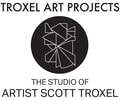WE BUILD ART EVERYDAY
ABOUT SCOTT TROXEL
Scott Troxel is an award winning, mixed media artist who specializes in wood and metal wall sculpture and freestanding sculpture. Scott has exhibited his work at numerous fairs and exhibitions across the United States, including The Other Art Fair New York, DIAF South Korea, Texas Contemporary, SCOPE Miami, SOFA Chicago, LA Art Fair, and Art Wynwood.
His works are held in corporate, hotel and private collections across the United States, Canada, Europe, Asia and South America and can be seen in iconic buildings like The Hotel Del Coronado and The Shard London. His work has been commissioned by Georgia Power, Live! Casino, The Palms Singapore, Capitol One, Northrup Grumman, Price Waterhouse Cooper and The Four Seasons Vail.
Scott was industrial designer and product developer, graphic artist and brand manager prior to transitioning to a full time artist in his early 40’s. His background in commercial products, graphics, design and aesthetics mirror similar artists like Andy Warhol who honed their artistic skills through real world applications prior to the shift into fine arts.
In addition to Troxel Art Projects, Scott is represented by galleries in the USA, Europe and Asia.
GALLERY JEON- SOUTH KOREA (EXCLUSIVE)
SHEWOLF GALLERY- AUSTIN, TX
GALLERY BRUNO MASSA- PARIS, FRANCE, ASIA
PARLOR GALLERY- ASBURY PARK, NJ
CARVER HILL GALLERY- CAMDEN, MAINE
His works are held in corporate, hotel and private collections across the United States, Canada, Europe, Asia and South America and can be seen in iconic buildings like The Hotel Del Coronado and The Shard London. His work has been commissioned by Georgia Power, Live! Casino, The Palms Singapore, Capitol One, Northrup Grumman, Price Waterhouse Cooper and The Four Seasons Vail.
Scott was industrial designer and product developer, graphic artist and brand manager prior to transitioning to a full time artist in his early 40’s. His background in commercial products, graphics, design and aesthetics mirror similar artists like Andy Warhol who honed their artistic skills through real world applications prior to the shift into fine arts.
In addition to Troxel Art Projects, Scott is represented by galleries in the USA, Europe and Asia.
GALLERY JEON- SOUTH KOREA (EXCLUSIVE)
SHEWOLF GALLERY- AUSTIN, TX
GALLERY BRUNO MASSA- PARIS, FRANCE, ASIA
PARLOR GALLERY- ASBURY PARK, NJ
CARVER HILL GALLERY- CAMDEN, MAINE
About TROXEL ART PROJECTS
Troxel Art Projects is the both the working studio and art fabrication business of artist Scott Troxel. Troxel Art Projects is a multi-faceted studio business which produces Scott's fine art and also offers complete creative and fabrication services for art advisors, interior designers, architects and public space projects. We employ a team of talented fabricators who specialize in art specific skillsets. Troxel Art Projects has placed artwork in some of the world's most iconic buildings and properties.
What can we build for you?
What can we build for you?

